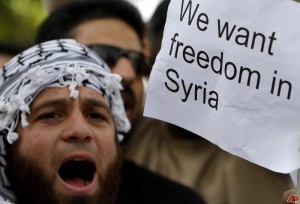 Thousands of protesters in Syria defied a ferocious crackdown and returned to the streets Friday, even in towns that the military had besieged only days before, in a relentless contest of wills that a leading dissident described as an emerging stalemate.
Thousands of protesters in Syria defied a ferocious crackdown and returned to the streets Friday, even in towns that the military had besieged only days before, in a relentless contest of wills that a leading dissident described as an emerging stalemate.
For successive weeks, Fridays have served as a weekly climax in the challenge to President Bashar al-Assad’s rule. Calls for demonstrations this Friday came after a withering wave of repression that has killed hundreds and detained thousands in towns and cities stretching from the Mediterranean coast to Damascus’s outskirts and the poverty-ridden south.
While some of the country’s most restive locales remained relatively quiet — namely Baniyas on the coast and Dara’a in the south — protesters took to the streets in at least four neighborhoods in Homs, Syria’s third largest-city and a center of the two-month uprising. Activists said protests ranged in numbers from hundreds to thousands.
“We don’t like you!” crowds chanted in Homs, referring to the president. “You and your party, leave us!”
Demonstrations were reported in at least six towns in the province around Dara’a. That protests erupted even in towns like Hara, where tanks entered this week, suggested that the Houran, knit by tradition and clan loyalties, was so restive as to be in revolt.
There were no immediate reports of deaths, but residents reached by phone in Homs reported gunfire, as did those in towns on the outskirts of Damascus, the capital. Other protests in Damascus and its suburbs were dispersed with tear gas and beatings.
“It looks like we have reached a dead end and we don’t see any light at the end of the tunnel,” said Aref Dalila, a leading dissident who met this week with Bouthaina Shaaban, a government adviser, who has opened talks with opposition figures. “The country that we know will not be able to survive; it is from the past. The current situation is dead; it is from the past. We should acknowledge the fact that change is needed and very necessary, and it will happen no matter how hard we try to resist against it.”
Mr. Dalila suggested that the stalemate would force the government to relent in its crackdown and offer reforms. But despite some tentative concessions early on, the government has shown no signs of willingness to introduce broad changes in a leadership that relies on family and sectarian loyalties, underpinned by the power of security forces.
For weeks, it has described the protests as an armed rebellion led by militant Islamists, saboteurs and even ex-convicts. It says nearly 100 soldiers and members of security forces have been killed, and their funerals have become a staple on Syrian state television. American officials have acknowledged that some protesters are armed, and residents fleeing to Lebanon spoke this week of armed clashes erupting in Homs.
Human rights groups and residents said more forces were deployed near Hama, in central Syria, and Baniyas, an oil industry town that was assaulted by the Syrian military last week. A resident in Baniyas said crowds at Friday Prayer were smaller than usual, and in contrast to past weeks, no demonstrations gathered afterward.
“People are extremely scared,” said Abu Obada, a resident there reached by phone. “They’re worried about snipers and they’re worried about the security forces.”
“Most of the people prayed at home,” he added.
The wave of repression stands as one of the most sweeping and brutal in the Arab Spring, inaugurated by revolutions in Tunisia and Egypt this year.
Residents have reported that hundreds of detainees are being held in soccer stadiums, schools and government buildings in towns and cities across the country, some of them arrested in door-to-door raids by black-clad forces carrying lists of activists.
Others have said the arrests are often arbitrary in a campaign that seemed motivated to bully people to stay indoors and to restore a measure of the fear that has buttressed the Assad family’s four decades of rule. Many young men have been forced to sign a pledge not to protest again.
“I only see this crisis becoming worse,” said Rassem al-Atassi, the president of the Arab Association for Human Rights in Syria, in Homs. Mr. Atassi himself was released last week after being detained for 10 days. “There’s no political solution.”
The brutality of the repression has led the United States and the European Union to impose some sanctions on figures in the leadership, though not on Mr. Assad himself.
Secretary of State Hillary Rodham Clinton moved the United States a step closer to calling for the ouster of Mr. Assad on Thursday as she denounced the crackdown.
“The recent events in Syria make clear that the country cannot return to the way it was before,” Mrs. Clinton said before a meeting in Greenland among Arctic nations. “Tanks and bullets and clubs will not solve Syria’s political and economic challenges.”
The Obama administration has criticized the Syrian government repeatedly and imposed some sanctions on several senior security officials, but it has not yet pursued aggressive diplomatic measures, including action at the United Nations Security Council.
Mrs. Clinton said that the United States would now pursue “additional steps to hold Syria responsible for its gross human rights abuses.”
“There may be some who think this is a sign of strength,” she said, “but treating one’s own people in this way is in fact a sign of remarkable weakness.”
A senior official elaborated that sanctions were being considered on additional Syrian officials. That could include Mr. Assad himself.
Ms. Shaaban, the adviser to Mr. Assad, said this week that Syrian officials thought that the American condemnations so far were “not too bad.” NYT
Leave a Reply
You must be logged in to post a comment.